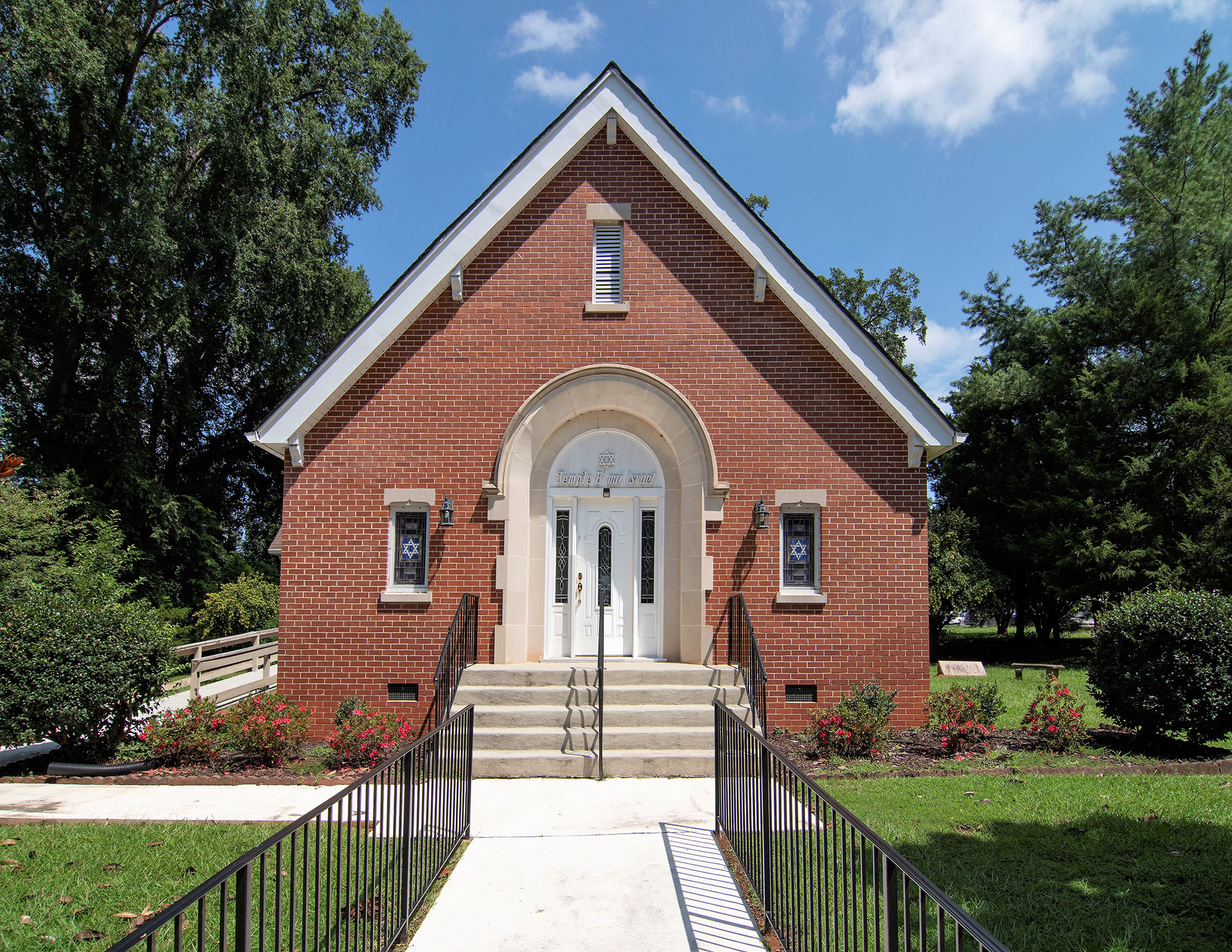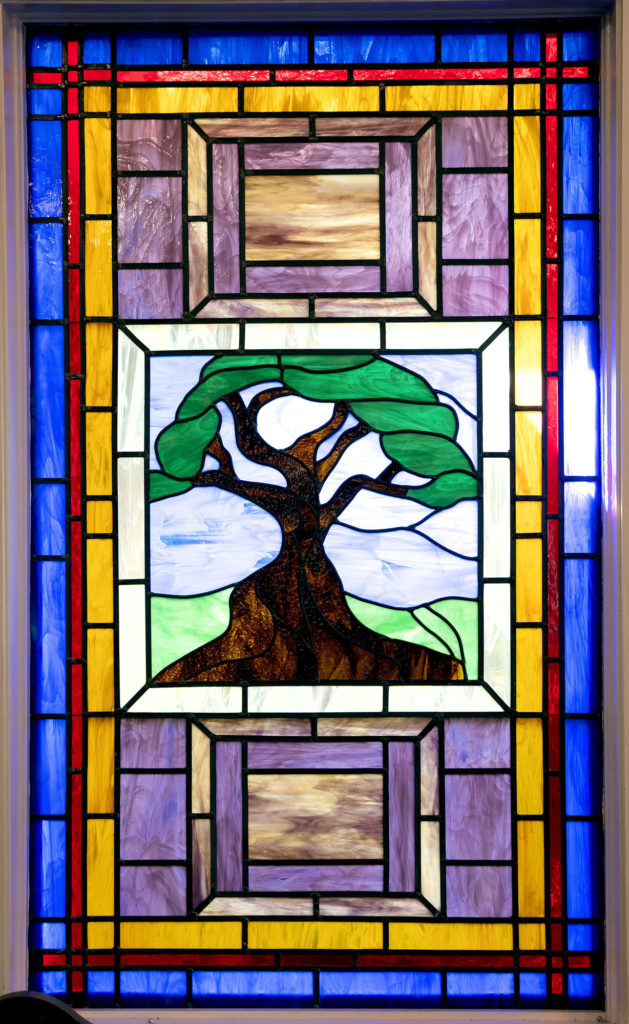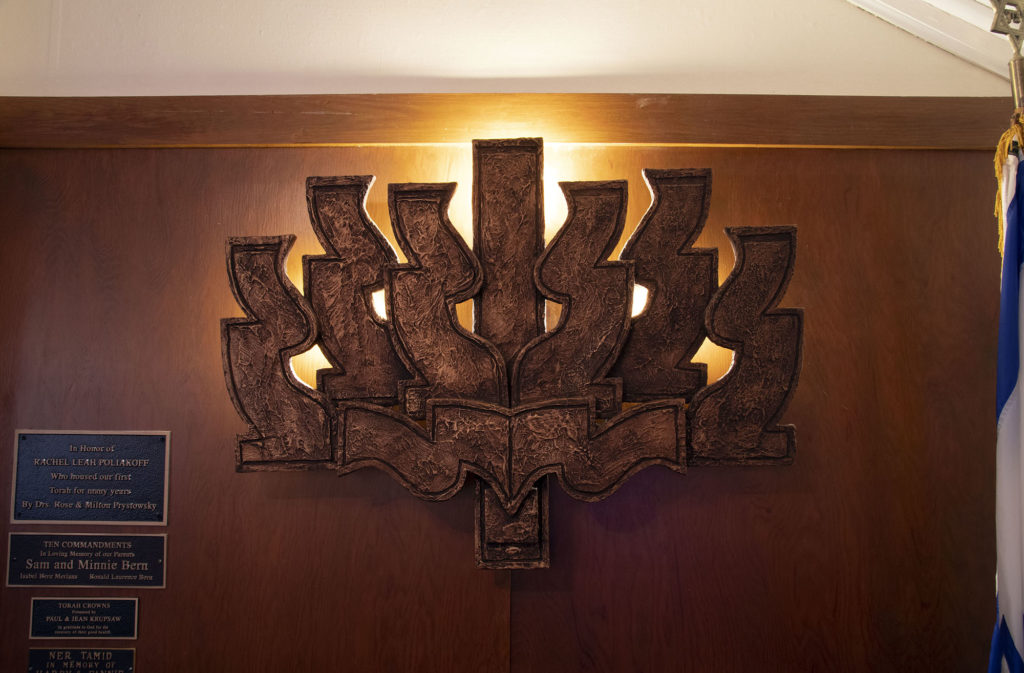
Temple B’Nai Israel
1302 N Oakland Ave
Anderson, SC 29621
Year Built: 1948
Architect: Unknown
Years Active: 1948-Present
Congregation History
Early Jewish History in Anderson
 Outside of Charleston, Anderson is home to one of the oldest Jewish communities in South Carolina. Anderson’s Jewish community dates back to the antebellum period when the first Jewish settlers in the city, Michael (1817-1892) and Martha (1830-1915) Lesser, emigrated in 1833 by way of New York and Georgia.1 After the Civil War, the Lessers cared for an injured Union soldier named Oscar Geisberg. Geisberg was a Viennese Jew, who in 1871, married the Lesser’s daughter, Carrie.2
Outside of Charleston, Anderson is home to one of the oldest Jewish communities in South Carolina. Anderson’s Jewish community dates back to the antebellum period when the first Jewish settlers in the city, Michael (1817-1892) and Martha (1830-1915) Lesser, emigrated in 1833 by way of New York and Georgia.1 After the Civil War, the Lessers cared for an injured Union soldier named Oscar Geisberg. Geisberg was a Viennese Jew, who in 1871, married the Lesser’s daughter, Carrie.2
The Jews of Anderson, including Michael Lesser, were merchants, mostly in the dry goods or general store business. Other Jewish-owned businesses included clothing, jewelry, musical instruments, and livestock.3 At the turn of the 20th century, Jews from Eastern Europe began arriving in Anderson in greater numbers.4
The Establishment of B’Nai Israel
The 1911-1912 edition of the American Jewish Year Book is the first known reference to the congregation B’nai Israel in Anderson, SC; H. Craft is listed as its rabbi.5 By the late 1930s, the Jewish population had grown to 72 people, most of whom were of East European descent and spoke Yiddish.6 Originally, congregants met in the Woodmen of the World hall and later, in a room above the grocery store on East Whitner Street as late as 1947.7 There, they would hold High Holy Day services, Sunday school classes, and Purim plays. The services followed Orthodox tradition, led by lay leaders, and men and women were segregated.8 English sometimes made its way into the Hebrew liturgy, but services were otherwise conducted in Hebrew. The Sunday school was led by Flo Fleishman and classes were taught by volunteer members of the congregation, such as Joe Fleishman and Hyman Draisen.9 In addition to teaching on a weekly basis, the volunteers would also help prepare students for their b’nai mitzvah.10
On April 23, 1945, the B’nai B’rith District Grand Lodge in Roanoke, VA granted Anderson, SC a charter for their own Lodge.11 On the charter were the names of 23 congregants, pledging to uphold the sanctities of B’nai B’rith: “Benevolence, Brotherly Love and Harmony.”12
Temple B’Nai Israel has seen a plethora of rabbis who have brought their wisdom and individual styles to the congregation through their services. Unable to maintain a resident rabbi, B’Nai Israel used alternative methods of finding someone to lead services. Similar to other congregations in South Carolina, Anderson’s Jewish community hired rabbinical students from New York to lead services for the High Holy Days.13 Occasionally, they would invite rabbis from nearby synagogues when available. A South Carolina rabbi named George Ackerman of Walhalla, a Hebrew teacher and cantor, was also hired to conduct services during the High Holidays.14 Another outside-contracted rabbi, Rabbi David Karesh from Columbia’s House of Peace synagogue, would come to Anderson to preside over services on Sundays, the one day a week all of the Jewish merchants would close their stores.15
With a growing Jewish population, the women of B’Nai Israel organized a Sisterhood affiliated with the National Federation of Temple Sisterhoods in 1932 with the help of Rabbi Gustave Falk, secretary of the Southeastern Conference of the Union of American Hebrew Congregations, and Harry Geisberg.16 The Sisterhood engaged in philanthropy as part of the federation and to raise funds, they sold Uniongrams, hand-lettered greeting cards. The proceeds of these Uniongrams went on to assist young rabbis at the Union of American Hebrew Congregation, now known as the Union for Reform Judaism. It was the Anderson Sisterhood that established the first Sunday school. They also were known to collaborate in philanthropic efforts with the Council of Church Women, and worked to supply milk to needy children, and contribute to numerous charities including the Hebrew Orphan’s Home in Atlanta, GA, the Denver Tuberculosis Hospital in Denver, CO, the Tuberculosis Association, The American Red Cross, and the Children’s Hospital.17
The Construction of the Synagogue
By the late 1940s, the Jewish population in Anderson had nearly doubled in size to 36 families as opposed to the previous decade. Community leaders, including Max Siegel, Nathan Fleishman, Hyman Draisen, Sam Bern, and Nathan Rosenblum, among others, began to advocate for the construction of a synagogue in Anderson. Temple B’Nai Israel was completed in 1948– a 150-seat sanctuary with a social hall, kitchen, and adjacent classrooms.18 Siegel desired to see the congregation’s first bar mitzvah held in a proper synagogue, as it was his own grandon Robbie Bern’s bar mitzvah.19
In the 1950s, members of B’Nai Israel began to debate their Orthodox affiliation. Louis Funkenstein, among others, urged the congregation to adapt its practices to align more closely with the Conservative movement.20 Nathan Fleishman encouraged his fellow elders of the congregation to “defer to the younger generation” regarding rituals to keep them engaged and wanting to participate in services. Finally, they came to a compromise, and weekly services began to follow Conservative customs, while High Holiday services were observed according to the Orthodox tradition.21 Men and women began to worship together. The congregation hired Rabbi Norman Goldberg, a retired Reform rabbi from Augusta, GA to lead services during the High Holy Days and regular services once a month. He also performed marriages and funeral rites.22
In the ‘60s and ‘70s, earlier generations reached maturity and moved away from Anderson, and the Sunday school experienced a gradual decline until it ceased operations in the 1980s. Participation in Shabbat services also decreased during this time. In response to wanning membership, B’Nai Israel joined the Reform movement, which has had a positive effect on synagogue participation. In the late 1980s, both Shabbat services and Sunday school attendance temporarily revived.23 The Sunday school officially closed its doors, however, in the 1990s, and the classrooms were converted into a second social hall.24
Today
 Despite the absence of a resident rabbi, B’Nai Israel has maintained a steady membership of approximately 30 families over the last fifty years. They continue to meet in the original synagogue, with its twelve stained glass windows depicting significant biblical events in Jewish history.25 The congregation has not maintained its relationship with the Union for Reform Synagogues. Today’s services do not explicitly align with either the Conservative or Reform movements.26
Despite the absence of a resident rabbi, B’Nai Israel has maintained a steady membership of approximately 30 families over the last fifty years. They continue to meet in the original synagogue, with its twelve stained glass windows depicting significant biblical events in Jewish history.25 The congregation has not maintained its relationship with the Union for Reform Synagogues. Today’s services do not explicitly align with either the Conservative or Reform movements.26
B’Nai Israel’s Sisterhood continues to function, though the B’nai Brith chapter has not been active for decades.27 The membership of the congregation has decreased over time and today, stands at 25 families.28 They meet on Fridays for Shabbat services led by members of the congregation, such as Dr. Peter Cohen and Mike Krupshaw, who also provide b’nai mitzvah training.29 On the High Holy Days, the honor falls upon B’Nai Israel members Dr. Robert Kimmel, Sc.D., and his son, Brian, to lead services in the synagogue.30
Architectural Description
Temple B’nai Israel is a one-story, three-bay wide brick structure built in the American Vernacular style with Romanesque influences. The front-facing shingled gable roof makes the formation of a ‘T,’ with the west (front) facade protruding outward, onto the street. Exposed brackets adorn the otherwise plain cornice on the wide eave overhang. On either side of the front door is a stained glass window featuring a Star of David. The windows come to an ogee point at the top, and have light sandstone lintels and sills. The front door is also surrounded by this same light sandstone material in a large archway. The round arch at the top has three stacked layers, giving the facade some depth. The vertical supports give off the illusion of a quoin pattern, usually seen on the corners of buildings. The design of the arch, however, emphasizes the entryway to the sanctuary as the facade’s main focal point. Above the door is a wooden half-moon pediment, painted white, with a Star of David and “Temple B’nai Israel” below it. The door itself is a seven-panel door with the eight and central panel being a window. On either side of the door are sidelights that make up ¾ of the section with one wood panel below them. The windows on the door and sidelights have decorative muntins to emulate stained glass. Leading up to the entryway, which sits on a raised landing, are five sandstone steps.
MST #923: Congregation B’Nai Israel, Anderson SC
Congregation B’Nai Israel in Anderson is home to the Holocaust Memorial Torah MST #923. Nazi authorities began to systematically persecute Jews immediately after the 1939 invasion of Czechoslovakia. Two years into this oppressive regime, Nazi leaders ordered Jewish congregations in Bohemia and Moravia to send all religious artefacts, including Sifrei Torah, to the Jewish Museum of Prague.1 There they lay in basement storage at the Pinkas Synagogue until their discovery after the war by the founders of the Memorial Scrolls Trust.2 The Trust continues to restore, research, and redistribute the scrolls to congregations throughout the world as memorials to the victims of the Holocaust. Anderson’s MST #923 originates from the southern Moravia village of Dolní Kounice.
The Dolní Kounice synagogue was finished in 1655—one of the oldest in the region.3 Built in the Baroque style, this ornate and historic structure still sits on an elevated location in the ancient former ghetto.4 Although the community traces its roots to the 13th century, by 1930, the Jewish population of the town was down to 53.5 Scroll #923 dates from an unknown year in the 19th century.6 Not long after Nazi occupation of Czechoslovakia, the local synagogue closed and sent its valuables to the Pinkas in Prague.7
In 1942, German forces deported the small Jewish community of Dolní Kounice to concentration and extermination camps.8 After the war, locals used the synagogue as a warehouse for some time before its renovation to serve as a cultural history museum honoring Jews murdered in the Holocaust.9 In its new home at B’Nai Israel congregants read from MST #923 on Yom Kippur as a memorial to the community of Dolní Kounice.

Figure: Synagogue of Dolní Kounice. From https://dolnikounice.cz/synagoga/ds-4774/p1=14844
1. Memorial Scrolls Trust, “Our Story: Bohemia and Moravia,” Memorial Scrolls Trust, n.d., https://memorialscrollstrust.org/index.php/our-history/bohemia-moravia.
2. Memorial Scrolls Trust, “Our Story: London,” Memorial Scrolls Trust, n.d., https://memorialscrollstrust.org/index.php/our-history/london-new; Memorial Scrolls Trust, “Bohemia and Moravia.”
3. Dolní Kounice Tourist Center, “History of the Town,” n.d., https://dolnikounice.cz/o-meste/ds-4773/p1=14833; Dolní Kounice Tourist Center, “History of the Synagogue,” n.d., https://dolnikounice.cz/historie%2Dsynagogy/d-82062/p1=14844.
4. Dolní Kounice Tourist Center, “History of the Synagogue.”
5. Museum of the Jewish People, “The Jewish Community of Dolni Kounice,” ANU: Museum of the Jewish People, n.d., https://dbs.anumuseum.org.il/skn/en/c6/e218614/Place/Dolni_Kounice; Dolní Kounice Tourist Center, “History of the Synagogue.”
6. Draisen, “Temple B’Nai Israel Anderson,” August 31, 2022.
7. Dolní Kounice Tourist Center, “History of the Synagogue.”
8. Museum of the Jewish People, “The Jewish Community of Dolni Kounice.”
9. Dolní Kounice Tourist Center, “History of the Synagogue.”
Endnotes
1. “ISJL – South Carolina Anderson Encyclopedia.” 2021. Goldring/Woldenberg Institute of Southern Jewish Life. 2021.
2. ibid.
3. Smith-Miles, Charmaine. “A community celebration – Anderson’s Jewish community has been part of the area for more than 100 years.” Anderson Independent-Mail (SC), April 23, 2016: 5A. NewsBank: Access World News – Historical and Current.
4. “ISJL – South Carolina Anderson Encyclopedia.” 2021. Goldring/Woldenberg Institute of Southern Jewish Life. 2021.
5. ibid.
6. ibid.
7. “ISJL – South Carolina Anderson Encyclopedia.” 2021. Goldring/Woldenberg Institute of Southern Jewish Life. 2021; Smith-Miles, Charmaine. “A community celebration – Anderson’s Jewish community has been part of the area for more than 100 years.” Anderson Independent-Mail (SC), April 23, 2016: 5A. NewsBank: Access World News – Historical and Current.
8. “ISJL – South Carolina Anderson Encyclopedia.” 2021. Goldring/Woldenberg Institute of Southern Jewish Life. 2021.
9. “Holding On: Temple B’Nai Israel of Anderson | Jewish Historical Society of South Carolina.” 2017. Jhssc.org. 2017. https://jhssc.org/holding-on-temple-bnai-israel-of-anderson/.
10. “ISJL – South Carolina Anderson Encyclopedia.” 2021. Goldring/Woldenberg Institute of Southern Jewish Life. 2021.
11. ibid.
12. Anderson B’nai B’rith Lodge No. 1577 Charter, 23 April, 1945.
13. “ISJL – South Carolina Anderson Encyclopedia.” 2021. Goldring/Woldenberg Institute of Southern Jewish Life. 2021.
14. ibid.
15. ibid.
16. ibid.; Anderson Sisterhood minutes book, College of Charleston Libraries, Charleston, SC, USA.
17. Anderson Sisterhood minutes book, College of Charleston Libraries, Charleston, SC, USA.
18. “ISJL – South Carolina Anderson Encyclopedia.” 2021. Goldring/Woldenberg Institute of Southern Jewish Life. 2021.
19. “Holding On: Temple B’Nai Israel of Anderson | Jewish Historical Society of South Carolina.” 2017. Jhssc.org. 2017. https://jhssc.org/holding-on-temple-bnai-israel-of-anderson/.
20. “ISJL – South Carolina Anderson Encyclopedia.” 2021. Goldring/Woldenberg Institute of Southern Jewish Life. 2021.
21. ibid.
22. ibid.
23. ibid.
24. ibid.
25. ibid.
26. ibid.
27. ibid.
28. “Holding On: Temple B’Nai Israel of Anderson | Jewish Historical Society of South Carolina.” 2017. Jhssc.org. 2017. https://jhssc.org/holding-on-temple-bnai-israel-of-anderson/.
29. “ISJL – South Carolina Anderson Encyclopedia.” 2021. Goldring/Woldenberg Institute of Southern Jewish Life. 2021; “Holding On: Temple B’Nai Israel of Anderson | Jewish Historical Society of South Carolina.” 2017. Jhssc.org. 2017. https://jhssc.org/holding-on-temple-bnai-israel-of-anderson/.
30. “ISJL – South Carolina Anderson Encyclopedia.” 2021. Goldring/Woldenberg Institute of Southern Jewish Life. 2021.























































































































































































































